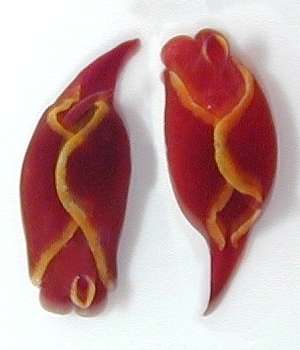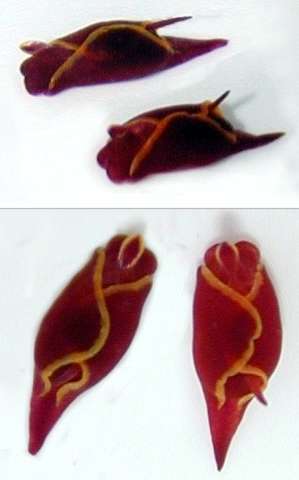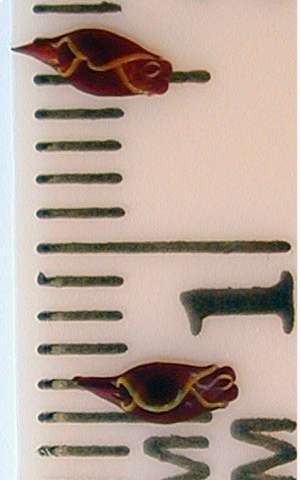Gastropteron rubrum from the Bahamas
January 16, 2004
From: Anne DuPont

Note added 20 January 2004. This is Gastropteron chacmol. See message
Dear Bill,
Thank you for identifying the slugs last month from the Bahamas. This winter seems to be a very productive year for headshield slugs here in the Southern Bahamas
And I have found another one that I cannot identify. Can you identify it for me, please?
They were found on January 5, 2004 about 2:30 PM. They were in 3-5 feet of water crawling on the sand during the day off Stocking Island, Exumas, Bahamas (Southern Bahamas). They are very active little swimmers, and at the slightest movement swim around before settling back down on the sand. Their size was approximately 1/8 inch long. I saw approximately 100 on that dive. This is the same beach that I also found the Philinopsis aeci, Philinopsis depicta, Aglaja felis, Chelidonura hirundinina and Chelidonura berolina.
Thank you for your time.
Cordially,
Anne DuPont
Delray Beach, Fl USA
akdupont@bellsouth.net


Dear Anne,
It may be a contradiction, but what are very abundant animals to you, are extremely rare to 'science' - which only shows how little we know. This is a species of Gastropteron, which is very timely as I am in the process of posting a number of messages about these animals from the western Pacific.
Your Gastropteron has been identified with the Mediterranean species Gastropteron rubrum by Abbott (1954, 1966) who reports it as 'moderately common' from Texas, Florida, West Indies to Brazil, and Marcus & Marcus (1960) report it from Florida and Sao Paulo, Brazil and also note an earlier record from Guadeloupe.
From the available information on the anatomy and colour variability of Gastropteron rubrum, I cannot say whether this is a correct identification for the Caribbean animals. It would certainly be useful to see more photos of this 'species' from both sides of the Atlantic. One other thing which would be nice to know is what thia animal eats. We don't know what any member of the family feeds on so if you have a large population to observe perhaps you could be lucky. Or perhaps you could try putting something tempting in front of one or two. My favourite guess would be a small flatworm.
• Abbott, R.T. (1954) American Seashells van Nostrand: New York. 541pp [and later editions]
• Marcus, Ev. & Marcus, Er. (1960)Opisthobranchs from American Atlantic warm waters. Bulletin of Marine Science of the Gulf and Caribbean, 10(2): 129-203.
Best wishes
Bill Rudman
Related messages
-
Gastropteron chacmol from San Andres, Colombia
From: Les Wilk, January 21, 2006 -
Re: Colour variation in Gastropteron chacmol
From: James Lyle, August 31, 2005 -
Gastropteron chacmol mating?
From: Anne DuPont, August 30, 2005 -
Re: Elysia from Belize?
From: Jim Lyle, February 21, 2005 -
Elysia from Belize?
From: Julianne Parolisi, February 19, 2005 -
Colour variation in Gastropteron chacmol
From: Marina Poddubetskaia, March 4, 2004 -
Gastropteron chacmol from the Bahamas
From: Colin Redfern, January 20, 2004 -
Gastropteron rubrum vs G. chacmol
From: Terry Gosliner, January 20, 2004 -
Gastropteron from the west Atlantic
From: Bill Rudman, January 20, 2004
